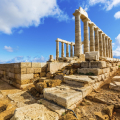CAPE SOUNION ARCHAEOLOGICAL SITE
Home to the columns of the famous Temple of Poseidon, which have dominated Cape Sounion since the century BC. Magnificent views.
This site (Αρχαιολογικός Χώρος Σουνίου/Archaiologikos Choros Souniou) is famous for its Temple of Poseidon, whose columns have dominated Cape Sounion since the5th century BC. Also known as the "Cape of Columns", this is a magnificent spot: 60 m above the waves, at the southern tip of Attica, with grandiose views over the Aegean Sea, especially at sunset. But it's often crowded, and the parking lot is undersized. As a result, vehicles park along the narrow road leading to the "sacred rock". Parking is sometimes impossible. The cape was used as a burial and ceremonial site as early as the 3rd millennium BC. The Athenians founded the sanctuary dedicated to the god of the Sea and Earthquakes around 700 BC. The mythological context is important: Athena was chosen as protector of Athens at the expense of Poseidon, who took revenge by ravaging the city. So, to appease his wrath and protect itself from earthquakes, the city dedicated this superb site to her. Tradition also has it that the legendary King Aegeus threw himself off Cape Sounion, thus giving his name to the sea bordering eastern Greece.
Fifteen columns facing the sea. The sanctuary was ravaged by the Persians in 480 BC, after their defeat at Salamis. You can begin your visit at the temples of Athena, opposite the parking lot. On a promontory, the bases of a small temple destroyed in 480 B.C. and those of a larger one (46.50 x 44 m) built around ten years later remain. The latter was abandoned in the 1st century AD and its materials reused in the Roman agora in Athens. The views here are already very beautiful. But it's the temple of Poseidon that offers the best panorama. Destroyed by the Persians, it was completely rebuilt between 444 and 440 BC (shortly before the Parthenon), then surrounded by a defensive wall in 413 BC. Smaller than Athena's (31.12 m x 13.47 m), 15 of its 38 marble columns (6.10 m high) are still standing, as are two sections of entablature. On two square columns, note the graffiti engraved by past travelers, including the poet Byron, who visited here in 1810 and 1811. Some of the friezes can be seen at the Lavrio Archaeological Museum. The Doric style of the building is reminiscent of the Temple of Hephaestus in Athens, built at the same time. Together with the temple of Aphaia, on the island of Aegina, they formed the "sacred triangle" of Attica.
Did you know? This review was written by our professional authors.
Members' reviews on CAPE SOUNION ARCHAEOLOGICAL SITE
The ratings and reviews below reflect the subjective opinions of members and not the opinion of The Little Witty.











Mais voilà l entrée ferme 20mn avant le coucher. (20h34). Arrivant à 20h11, l entrée nous est refusée car le chef a dit de fermer à 20h30. Impossible de discuter, de promettre de ne pas être le dernier à revenir. 20h11 + 20mn= 20h31 soit 3 mn avant le coucher .
Non le chef a dit. D ailleurs le chef n est pas sur place. On repart aigri devant si peu de considération .
Je rejoins l avis précédent, finalement à voir de loin.